Tagged: T-shirts
Spot the difference: racing in Texas vs Britain
Running is among the most universal of all physical activity. No matter where you go in the world, running is, well, running. You can run in the hot and cold, in cities and in the country, on paved roads and muddy trails, and many other variations – but it’s essentially the same thing. It’s running.
But there’s also a culture attached to running – and that culture varies massively around the world. The culture, customs and idiosyncrasies that are involved in taking part in a race in Britain are very different from those in, say, Texas.
I’d realised some of the differences in the process of entering the 2017 Chevron Houston Marathon – and I’d also picked up some details from my Texas-domiciled brother, who has taken part in a handful of races and triathlons.
But you can’t beat first-hand experience, and that was part of the appeal of tackling the Houston Half Marathon on a recent trip to Texas. I was able to pick up some useful details both about doing a race in Houston, and about the culture of running in the Texas and the USA.
I’ve already written about the oddity of being classified an elite runner – at least by the Houston Half organisers. Here are some other differences I noted.
1: Texan races start early
This wasn’t technically a surprise – the 0700hrs start time of both the Houston Half and the Houston Marathon are clearly noted on their websites. Given that Texas can get quite hot (of which more later), it makes sense. And while I’ve done races in Britain that start early, I’ve never done one that started before it was properly light.
Aside from the early alarm call necessitated by start time, it was a cool experience: running between huge skyscrapers through downtown Houston as the sky began to lighten was a fantastic experience.
2: Texan runners aren’t afraid to go topless
Well, male runners at least. And the practice did seem largely confined to a number of the runners in the elite start corral. You do see the occasional runner training without a shirt on when temperatures soar in the UK, but it’s not a common sight in races.
Still, without wishing to repeat myself, given that Texas can get quite hot (of which yet more later), it makes sense. Although as a pasty-skinned British bloke, I won’t be joining them any time soon.
3: You get the T-Shirt before you run
Plenty of races hand out T-shirts as a souvenir/reward for taking part – usually featuring a big event logo and lots of sponsor logos, and often in a pretty lurid colour. The Houston Half Marathon T-shirt fitted the bill, especially coming in a fetching shade of luminous green. But there was a difference – when you were given the T-shirt.
In Britain, every run I’ve done that’s featured a reward shirt has handed them out at the finish – in effect, they’re a finishers’ prize. Don’t finish the race? Sorry, you don’t get a T-shirt. Harsh, but kinda fair.
The Houston Half Marathon (and, from checking, lots of American races) gave the T-shirt out at ‘packet pick-up’. Which led to the unusual – to me, anyway – sight of people doing the race in the official event T-shirt. It seemed… odd.
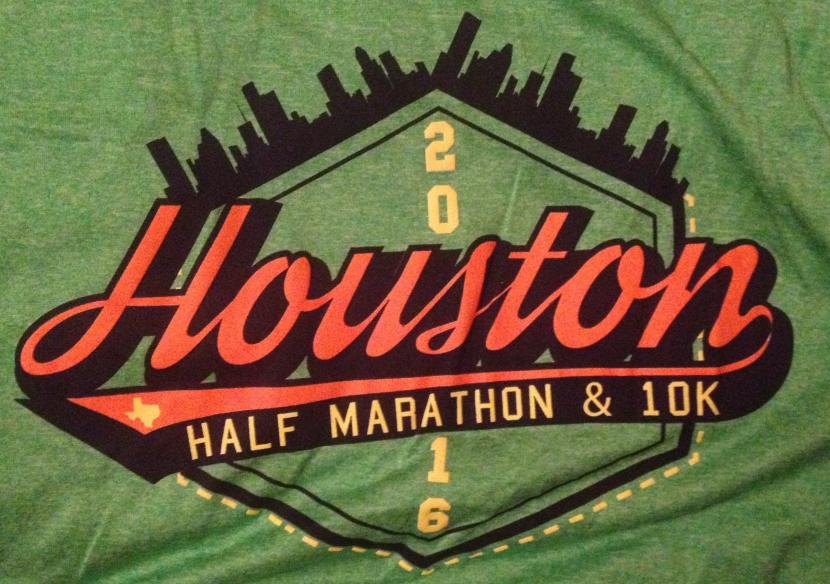
Green is the colour (for the Houston Half T-shirt, at least)
4: Drinks come in paper cups
Now, this could be a big issue. For me, at least. Most races in Britain that feature water stations offer up the water in plastic cups. The London Marathon, and a few of the bigger races I’ve done, hand out bottles of water and Lucozade Sport. Given my struggles to effectively drink out of plastic cups while running (previously documented here), I like bottles. You can grab a drink, and take your time consuming it, with far less risk of spilling it all down yourself.
The Houston Half Marathon had regular water stations on the course, with a choice of water or Gatorade Endurance Formula. But those stations didn’t feature bottles. And they didn’t feature plastic cups. They featured… paper cups. They were lovingly brands Gatorade cups, but they were still relatively flimsy paper cups.
This was a challenge. Grabbing a cup off one of the wonderful volunteers without slowing down or spilling the drink everywhere by squeezing too hard was difficult. Hoisting that cup up to my mouth without slowing down or spilling the drink everywhere was difficult. Actually getting the drink down my throat without slowing down or pouring it down my top was difficult.
In short, in my attempts to consume water or Gatorade I probably spilled more drink over me or the volunteers than I actually managed to drink. And given the humidity in Houston – even at 7am on a misty morning – I really needed that drink. Late on, I actually had to briefly slow to a gentle jog to ensure I took a decent drink. That was time lost.
I’ve checked, and it seems the Houston Marathon is also likely to provide drinks in paper cups. This could require some practice…
5: The race number – sorry, bib – came with coupons
Leaving aside the terminology difference for now (I say race number, you say race bib; I say tomato, you say tomato, etc, etc. I’ll return to this in a future post…), my Houston Half Marathon race number featured something I’ve never seen on a run in Britain: coupons.

Mmmmmm, free tacos
I’ve done a couple of races in Britain that have featured a detachable bag drop tag, but when most events have post-race freebies, the usual form in Britain is just to scribble a mark on your race number. Not on the Houston Half Marathon.
My race number (yes, the bright yellow elite one) featured three tear-off coupons that could be handed in after the race. Two of them were for free beer, the other was for free tacos (courtesy of the good folks at Taco Cabana). Being the non-drinking type, I didn’t partake in the beer (my brother, who also ran, didn’t either, but largely because he couldn’t face the lengthy queue. Free beer is apparently quite popular after a half-marathon. Who knew?), but I did very much enjoy some free tacos. Which brings me to…
6: The free food at the post-race party
Most races in Britain hand out some level of free food and drink after a race. That ranges from the basic (water and bananas), to a bit of a choice (water, banana, energy bars, chocolate bars), to the pleasingly British (free home-made cake – oh, and water and bananas), to the downright odd (free Ambrosia custard and rice pudding).
But it’s usually a fairly limited thing. Heck, even the London Marathon free food was limited to a bag full of goodies (including energy bars, chocolate, Lucozade Sport, crisps, beef jerky – and water and a banana).
The Houston Half Marathon? Well, you could exchange your taco token for a bounty of food, including those Taco Cabana hot tacos (well, they said tacos: they were actually burritos) and IHOP pancakes, a host of biscuits and energy bars and oranges. Oh, and bananas. Because every good run has free bananas.
That wasn’t all. There were ice buckets full of soft drinks, the aforementioned free beer, and free shaved ice and other goodies on offer. With the finish in a lovely park on the edge of downtown Houston, all the runners were really encouraged to stick around and indulge, giving the post-race party a lovely atmosphere.
Okay, so those were the major differences. But the biggest thing I picked up was actually a similarity:
A half-marathon is a half-marathon
I’ve now done four half-marathons in 2016: in Wokingham, Hampton Court, Bristol and Houston. All four of them were entirely different events in different locations, with different courses and different vibes. But, ultimately, they all involved running 13.1 miles.
And that’s the thing. The scenery, topography and culture might change, and the course might change, but as I noted at the start of this post, running is running. And that’s what I need to remember as I build up to the Houston Marathon.
Running a marathon in Houston, Texas seems a very different proposition to running a marathon in London, England. Which is something I’ve spent a lot of time pondering. But those differences are only around the edges. Once the race starts, the challenge is the same: run 26.2 miles. And I proved earlier this year that I know how to do that…
Oh, something else I’ll take away from the Houston Half Marathon: the scenery. Well, a bit of it. It was a ridiculously misty morning in Houston, and I spent much of the event with little to look at but the road ahead of me and fog-shrouded buildings. But as I reached the final mile or so, heading back to downtown Houston, the mist began to break – while still hanging on low to the ground. That created the amazing sight of the seeing Houston’s skyscrapers gleaming in blue sky and morning sun, while seemingly rising out of the mist still clinging to their bases.
It was a beautiful sight. It’s probably just as well I don’t run with my phone – I’m not sure I’d have been able to resist stopping to take a picture.
The rewards of running (does it mean a thing if you don’t get some bling?)
A statement to file in the ‘cliche but true’ category: running is it’s own reward. Frankly, unless you’re a professional (or aspiring to be one), most runners enter events not for glory or riches, but for the warm feeling of satisfaction that comes with completing an athletic endeavour – hopefully in a Personal Best time.
Yet if running really is it’s own reward, why do the organisers of just about every paid-for race always provide some form of prize for finishers? And why is there always something thrilling about being handed your finishers’ prize.
When it comes to running prizes, the most common remains the medal. And, while it’s a long way from an Olympic gold, there is something quite nice about walking away from a run with a little bit of shiny metal hanging around your neck.
Now, you do get some medals that seem a bit basic – classic bits of metal with runners or a similar design on. They’re nice, but… a bit simple.

Medals featuring running things. Simple, but effective
What’s more pleasing is completing a race which offers a far more customised, bespoke medal – it’s a nice touch that shows the effort many event organisers put in to make sure their event (and prize) stands out as a little bit special.
Sometimes that means a medal with a design that reflects the venue: a picture of a stag for the Bushy Park 10k, or a Christmas design on a festive-themed race held in late December.
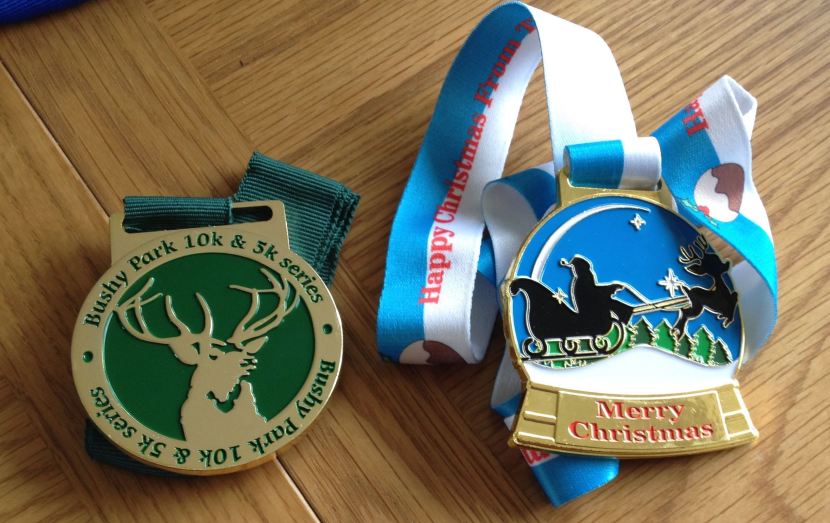
Medals with theming: deer and Christmas. Colourful, too…
Or perhaps a medal shaped like a dragon for the Wyvern 10k, reflecting the logo of Wyvern College, which hosted the race HQ (and no, the Wyvern 10k isn’t in Wales, but near Eastleigh in Hampshire).
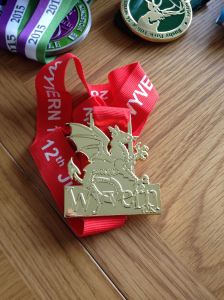
Who wouldn’t want a medal shaped like a dragon?
And some medals stand out just for being big, chunky and colourful.
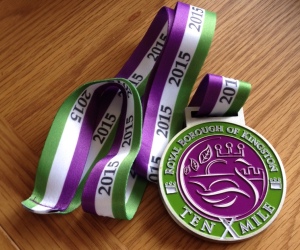
Medals don’t have to be gold, silver or bronze: green and purple works too
Yes, we like medals. Except there’s just one problem: what do you do with them after a run? Sure, they’re nice to show off, but you tend to end up with a lot of them. And unlike, say, an Olympic gold for winning a race against world-class opposition, you probably don’t want to hang a series of medals for finishing somewhere mid-pack in a race of a few hundred amateurs up on your wall. Well, you might, but if you end up entering lots of races, you can end up with a lot of medals.
My growing collection started taking up space in a rough pile on the top of a bookcase, until a visit from my Mum came up with a better solution: she bought me a jar to put them in.
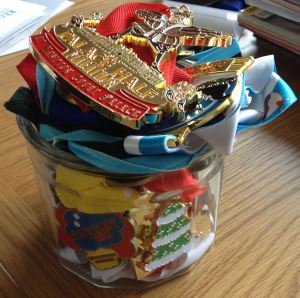
My medal jar. Yup, I need a bigger one
Here’s the thing though: medals aren’t the only finishing prizes that are offered by races. And some of the other prizes might not be as shiny, but are far more useful. The next most common prize I’ve encountered are technical T-shirts – and, as every runner knows, you can never have too many running T-shirts.
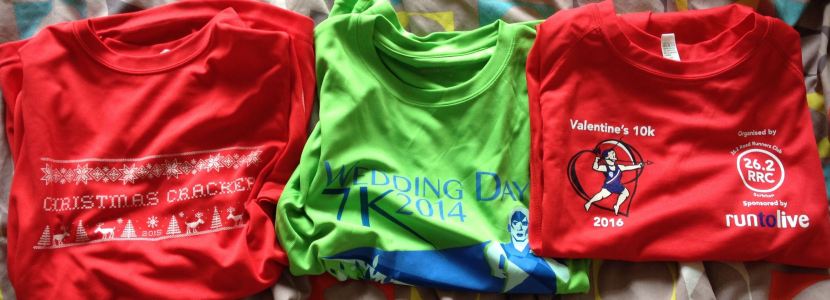
Prize T-shirts: bright and useful
Helpfully for me, lots of the T-shirts given away as prizes come in somewhat bright colours, which is very useful – if you’re going to run in the dark in winter you need bright colours, and as someone who doesn’t like standing out much, I’m rubbish at buying brightly coloured clothes. So getting them as prizes saves me a lot of bother. And yes, there is something quite satisfying about going out running in a T-shirt that shows other runners you’re a proper runner who’s done races and everything.
There’s also a brief nod of respect here to some of the bigger events that have multiple prizes: the Hampton Court Palace Half-Marathon I did recently offered a T-shirt and a medal – and the medal is perhaps the finest, most original I’ve received to date.
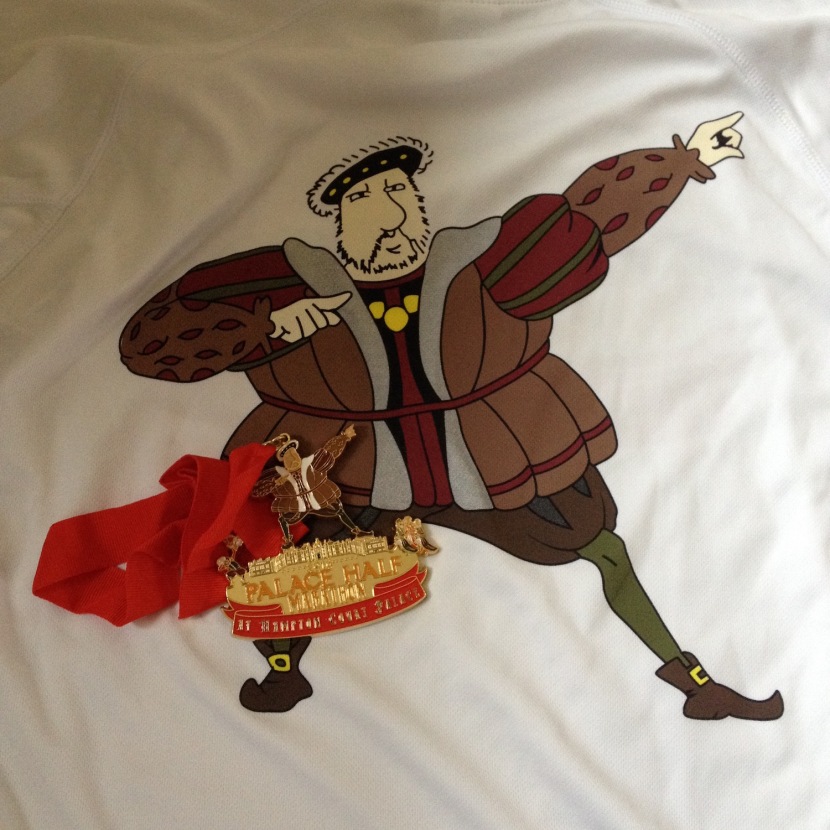
Kudos to this genius T-shirt and medal combo
Then there are even more creative prizes. The Thames Towpath 10 is sponsored by the Fullers brewery, and so the finishing prize is a pint glass. Even as a non-drinker, it’s one of my favourite glasses. Another event gives every finisher a mug – which is strangely satisfying to reflect on every time I slurp tea from it.
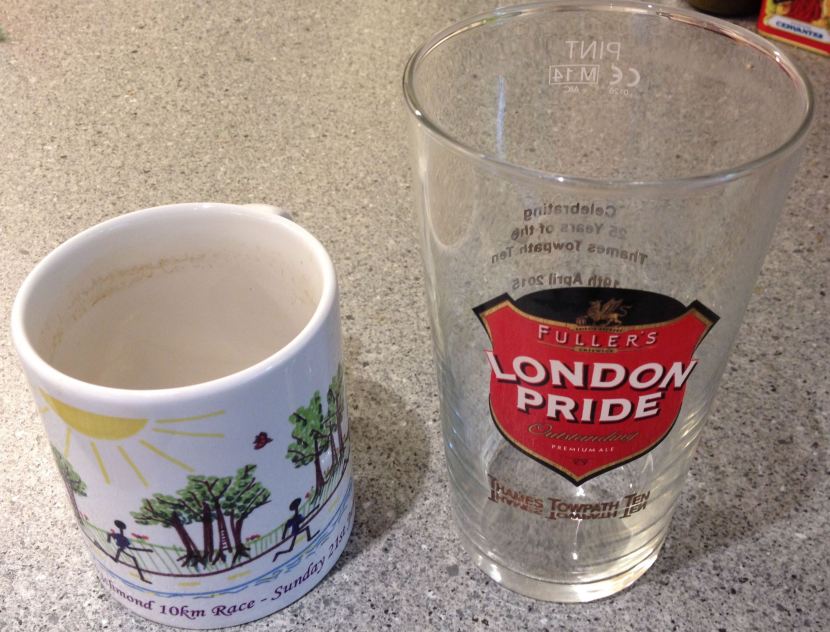
A prize mug and a pint glass. And yes, the mug does need a wash. But it’s proof I use it…
What’s notable about the T-shirts, mugs and glasses I’ve been given as prizes is that I use them regularly – while the medals have ended up in a corner of my room in a pot. Is that a sign that more events should be thinking outside the medal when it comes to prizes?
Possibly, except the truth is it really doesn’t matter. Because the truth is I really don’t do it for the finishing prize. It’s a lovely gesture, and always makes the end of a race that bit more enjoyable. But, as I started by saying, the real reward of completing a race is in the running it took to do it. Any finishing prize on top of that is a nice bit of icing on a cake (a sweaty cake with aching legs, obviously).
Having said all that, I already know that, should I finish the London Marathon in two weeks or so, the medal I’ll get for doing so will instantly become one of my most prized possessions. Am I running for that medal? No, but it will be a shiny, metallic bit of proof of my achievements.
I’m running the 2016 London Marathon to raise money for the South West Children’s Heart Circle, who help care for children undergoing heart surgery in the south west of England. Any sponsorship received would go to a great cause – click the ‘Just Giving’ button for details of how to donate. Thanks!

